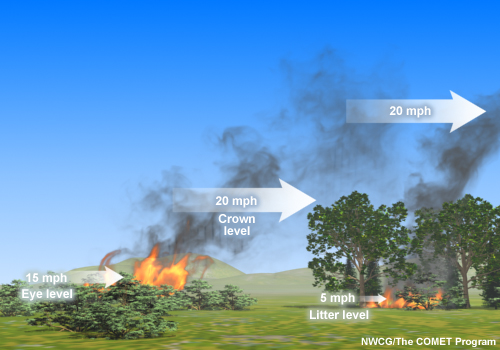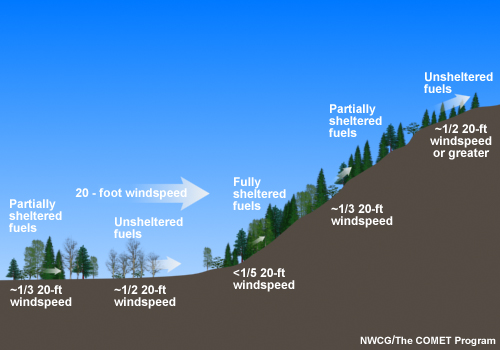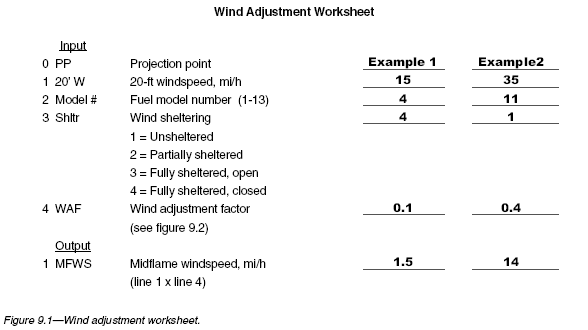8.2 Midflame Windspeed
8.2 Midflame Windspeed Anonymous (not verified)Midflame windspeed (MFWS) is defined as the velocity of the winds, in miles per hour (mi/hr), taken at the mid-height of the flames. MFWS will directly affect the direction of movement of the flaming front and is important in fire spread calculations. The midflame windspeed is determined by use of the wind adjustment table, which provides values in terms of fuel overstory exposure and fuel model.

Figure 8.2 Adjustment factors for midflame winds.
The adjustment values are typically applied to the 20-foot windspeed, which is the speed that is measured 20 feet above any fuel or obstruction, usually by a weather station. The midflame windspeed is obtained by multiplying the 20-foot windspeed by the appropriate wind adjustment factor from the table.

Figure 8.3 Effects of fuel sheltering on wind speeds.
It is very important to know which fuel model and sheltering configuration is being studied, and whether a given windspeed is a 20-ft windspeed or an already adjusted midflame windspeed.

Figure 8.4 Typical fuel sheltering for slope locations.
The midflame windspeed will be LESS THAN the 20-foot windspeed, because vegetation and friction slow down winds closer to the surface. That is why all the adjustment factors in the table are less than 1.
Example 1 - A fire is burning in a fully sheltered area of dense, or closed, stands described as Fuel Model 4. The local weather station reports the 20-ft windspeed is 15 miles per hour. What is the midflame windspeed? Show all work on the wind adjustment worksheet (see below).
Solution - The figure above describes wind reduction factors and is used to determine the appropriate correction factor.
Step 1. The correction factor is 0.1 for any fuel model under fully sheltered conditions with dense stands.
Step 2. To find the midflame windspeed, multiply the 20-foot windspeed by the adjustment factor.
midflame windspeed =
20-foot windspeed × adjustment factor
MFWS = 15 mi/h × 0.1 = 1.5 mi/h
Example 2 - A 20-foot windspeed at the top of the ridge is reported to be 35 miles per hour, with fuel model 11 vegetation. What is the midflame windspeed?
Step 1. See figure 8.4. The top of a ridge is indicated to be unsheltered.
Step 2. From figure 8.2, the adjustment factor is 0.4.
Step 3. MFWS = 35 x 0.4 = 14 mi/h
The values can be summarized in a wind adjustment worksheet.
